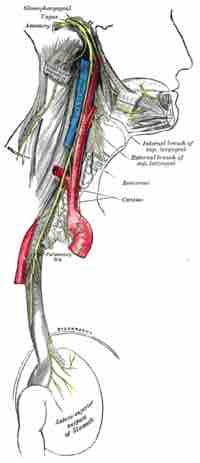Anatomic Description
The accessory nerve (cranial nerve XI) controls the sternocleidomastoid and trapezius muscles of the shoulder and neck. It begins in the central nervous system (CNS) and exits the cranium through a foramen.
Unlike the other 11 cranial nerves, the accessory nerve begins outside the skull. In fact, most of the fibers of the nerve originate in neurons situated in the upper spinal cord.
The fibers that make up the accessory nerve enter the skull through the foramen magnum and proceed to exit the jugular foramen with cranial nerves IX and X. Due to its unusual course, the accessory nerve is the only nerve that enters and exits the skull.
Traditional descriptions of the accessory nerve divide it into two components: a spinal component and a cranial component. However, more modern characterizations of the nerve regard the cranial component as separate and part of the vagus nerve.
Therefore, in contemporary discussions of the accessory nerve, it is common to disregard the cranial component when referencing the accessory nerve and assume reference to the spinal accessory nerve.
Accessory Nerve Function
The accessory nerve provides motor innervation from the CNS to the sternocleidomastoid and trapezius muscles of the neck. The sternocleidomastoid muscle tilts and rotates the head, while the trapezius muscle has several actions on the scapula, including shoulder elevation and adduction of the scapula.
During neurological examinations, the function of the spinal accessory nerve is often measured by testing the range of motion and strength of the aforementioned muscles. Limited range of motion or diminished muscle strength often indicates injury of the accessory nerve.
Patients with spinal accessory nerve palsy may exhibit signs of lower motor neuron disease, such as atrophy and fasciculations of both the sternocleidomastoid and trapezius muscles.

The accessory nerve
Upon exiting the skull via the jugular foramen, the spinal accessory nerve pierces the sternocleidomastoid muscle before terminating on the trapezius muscle.